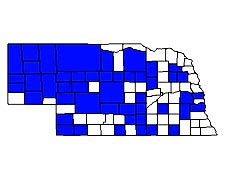
| Cicindela scutellaris Say |
| Adult Length: 10.5 to 14.5 m |
| Appearance: Two subspecies of this insect can be found in Nebraska. Cicindela scutellaris lecontei is limited to the eastern edge of the state near the Missouri River west to at least Lincoln. C. scutellaris scutellaris is found across the remainder of the state. Intergrades between the two subspecies can be found from the eastern edge of the state to at least Dawson County. As with C. formosa, the prevalence of lecontei-like traits increases to the east. It does appear that lecontei-like traits are exhibited slightly further west than generosa-like traits are exhibited in C. formosa. In Buffalo County most individuals at least some intergrade traits (brassy head and pronotum,green cast on front of elytra and/or presence of whitish maculations), and in Dawson County at least one-third do. Cicindela scutellaris lecontei Haldeman This subspecies exhibits pale maculations on the elytra, which are completely lacking in C. scutellaris scutellaris. The extent of the maculations is somewhat variable, and vary from a series of eight small dots near the outer edge of the elytra to a complete margin of fused pale markings. In most cases the markings consist of a c-shaped humeral marking in the front, a triangular mark near the middle, and an l-shaped apical marking near the apex. The humeral and apical (rarely) markings may be broken. The ground color is also somewhat variable. Adults can be pinkish red, brassy red, or brassy green. In some cases the head and pronotum may be brassy green while the elytra are brassy red. Most individuals are brassy red in color. Intergrades between ssp. lecontei and ssp. scutellaris are extremely variable. The presence of maculations on otherwise ssp. scutellaris individuals usually suggests some intergradation with ssp. lecontei, and individuals of ssp. scutellaris with a strong green suffusion near the front of the elytra suggest likewise. Cicindela scutellaris scutellaris Say This subspecies normally lacks pale maculations entirely. The head and pronotum are blue to greenish blue, strongly contrasting with bright red elytra. Elytra may occasionally be dark red. The brilliant colors of this insect are truly striking. The abnormal specimen pictured was collected in Harlan County in 2004. The unusually heavy markings are similar to those of ssp. yampae, a subspecies limited to northwestern Colorado. |
| Similar Species: Cicindela scutellaris lecontei is unlikely to be mistaken for any other species because the middle band is always limited to a triangular mark near the elytral margin. Greenish individuals are never as green as C. sexguttata. The nominate subspecies could be confused with C. splendida, but C. splendida has a green or blue margin on the outer edge of the elytra, which is lacking in C. scutellaris scutellaris. |
| Biology: This species inhabits dry sandy soils with sparse vegetation. Though both larvae and adults of both C. scutellaris and C. formosa can be found together, this species is usually more common on somewhat hard-packed sands, while C. formosa is usually more common on loose sandy soils. This species also seems to be slightly more tolerant of vegetation. Adults are fairly skittish and are quick fliers. Adults usually fly less than 10 meters in a looping pattern when alarmed. |
| Adult Life History: Adults emerge briefly in late summer, mostly appearing in late August and early September before overwintering. Adults resume activity in April, and peak numbers are reached from late April to late May. Numbers begin to decline in June and adults are scarce by July. |
| Larval Life History: Larvae of this species occur in vertical burrows in dry sandy soils. Burrows may be as deep as 50 cm. Larvae are often found in more densely vegetated areas than those of C. formosa. This species probably has a two-year life cycle in Nebraska. Eggs are laid in April and May and most larvae reach the third instar by September. Pupation occurs the following summer. Larvae are fairly aggressive and can easily be fished out with a long grass blade. |
| Biogeography: This species is common throughout the Sandhills Province, and can be locally common in many other sandy areas. Like C. formosa, it readily colonizes old sand pits and occurs in many such areas in the Platte River Valley. In North America it occurs across most of the United States east of the Rocky Mountains, but is lacking from much of the Appalachian region. An isolated population occurs in western Colorado. It also occurs in southern Canada. Eight subspecies are recognized, but there is some disagreement on one. |












